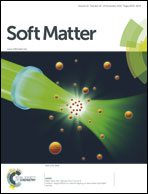Polysaccharide films at an air/liquid and a liquid/silicon interface: effect of the polysaccharide and liquid type on their physical properties
Abstract
We investigated the effect of the polysaccharide type, the subphase on which the Langmuir monolayers were prepared, and the liquid in which the properties of the transferred monolayers were measured on the physical properties of the polysaccharide films at an air/aqueous interface and at a silicon substrate, and the forces and friction of the polysaccharide transferred films when measured in solution against a silica probe. Chitosan was modified with a silane coupling agent to make chitosan derived compounds with a low and a medium molecular weight. Chitin and the chitosan-derived compounds were used to make Langmuir monolayers at air/water and air/pH 9 buffer interfaces. The monolayers were transferred to silicon substrates via Langmuir–Blodgett deposition, and the chitosan-derived compounds subsequently chemically reacted with the silicon substrates. Atomic force microscope force and friction measurements were made in water and in the pH 9 buffer, where the water and the pH 9 buffer acted as a good and a bad solvent for the polysaccharides, respectively. The polysaccharide type affected the friction of the polysaccharide film, where the physically adsorbed chitin gave the lowest friction. The friction of L-chitosan was higher than that of M-chitosan in water, suggesting that the molecular weight of the polymer affects its lubricating ability. The forces and friction of the polysaccharide films changed when the subphase on which the Langmuir monolayers were formed was changed or when the liquid in which the properties of the films adsorbed at the silicon substrate were measured was changed. The friction increased significantly when the liquid was changed from water to the pH 9 buffer. This increase was explained by the reduced charge of the chitin and chitosan-derived materials due to the pH increase, the screening of the charges by the salts in the buffer, and the possible hardening of the monolayer caused by the adsorption of salts from the buffer.


 Please wait while we load your content...
Please wait while we load your content...